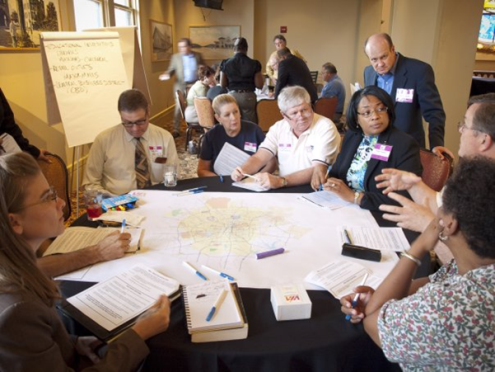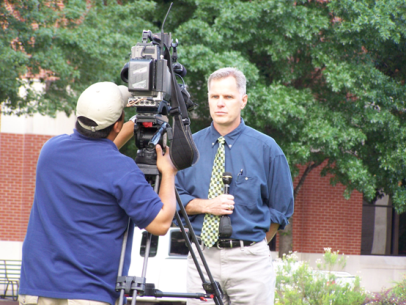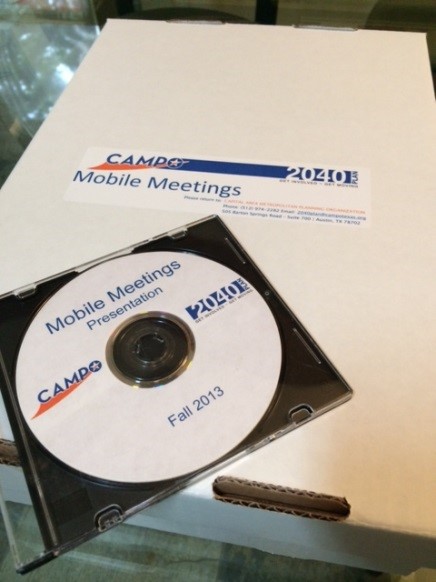Public Engagement | Plans, templates and tools
Traditional public involvement
Website
The project communications team shall develop a dynamic, interactive and accessible website or webpage for appropriate projects and programs.
The site should be easy to use and include a project summary, projected schedule/timeline, project updates, public meeting schedules, frequently asked questions (FAQs), copies of fact sheets and newsletters, etc. as well as a mechanism to communicate back what was heard and how it was used from previous engagement. The site should also be easy to navigate and visually appealing to keep people returning to the site.
The project team should update information monthly or more frequently as new information becomes available. The primary purpose of the website should be to provide online opportunities for the public to learn about the planning process through unique and tailored web tools. These tools should include an update subscription service (such as Constant Contact or GovDelivery) that allows members of the public to sign-up to receive information/alerts about the project through email and/or social media. Subscribers should be able to specify the type of information they wish to receive and to receive specifically that information electronically. Provide a quick and simple method for unsubscribing at any time.
Action to be taken
- Drive traffic to the project webpage from official MnDOT channels
- Ask partner agencies to provide links to the web page
Details
- Develop website content, page schematic and ultimate design
- Include website address in all materials and presentations and encourage visits to learn more
- Create email updates subscription service including user-friendly process for unsubscribing
Public workshops

During workshops, participants are divided into small groups to work with a project team member to answer questions about a particular project or initiative. These are intended to be highly interactive sessions in which maps and colored markers are used to illustrate the concepts being proposed and under development. At the end of the workshop, facilitators bring all the small groups together to present their work and participate in a conversation led by the project team about the common themes emerging and how those ideas could be integrated into the planning process.
Action to be taken
- Recruit community members to take part in the public workshop through the use of postcard mailing to residents, emails to stakeholders, a media release, outreach to area employers, online outreach and through the Project Advisory Committee
Details
- Develop workshop materials to include a PowerPoint presentation, exhibits, handouts and discussion guides
- Process feedback collected and develop a public workshop summary report
Public meetings
Public meetings are the most traditional method of involving the public. Typically public meetings consist of introductions, an overview presentation, opportunities to ask questions, visuals of project and a wrap-up. Some public meetings begin with an open house where attendees can come learn about how the plan was developed and the recommendations it includes.
Action to be taken
- Invite community members to take part in the public meeting through the use of postcard mailing to residents, emails to stakeholders, a media release and outreach to area employers
Details
- Develop meeting materials to include a PowerPoint presentation, exhibits, handouts and discussion guides
- Process feedback collected and develop a public meeting summary report
Public workshop/meeting prep and coordination timeline
| Tasks | Timeline |
|---|---|
| Secure location | 60 days prior to event |
| Develop bilingual workshop/meeting notice information | 45 days prior to event |
| Submit workshop/meeting information to neighborhood associations, chambers of commerce and agency newsletters for dissemination | 45 days prior to event |
| Distribute flyers to organizations that meet on a monthly basis | 45 days prior to event |
| Draft postcard content for review | 45 days prior to event |
| Post date on community calendars and websites | 45 days prior to event |
| Distribute public service announcements to area radio stations when fitting | 45 days prior to event |
| Finalize draft postcard | 35 days prior to event |
| Send postcard to printer for production | 30 days prior to event |
| Secure simultaneous translator (if necessary) | 30 days prior to event |
| Publish display and electronic media ads | 30 days prior to event |
| Produce and install bilingual bus placards on buses | 30 days prior to event |
| Produce and place bilingual workshop/meeting flyers on buses | 30 days prior to event |
| Mail out postcard to project database | 30 days prior to event |
| Request that local universities send out email announcements to their students, faculty and staff | 30 days prior to event |
| Produce agenda, comment card workshop/meeting handouts | 20 days prior to event |
| Coordinate with local professors in the areas of planning, geography and political science and request that they encourage their students to participate | 20 days prior to event |
| Send out email blast with public workshop/meeting information and link to web page | 20 days prior to event |
| Post public workshop/meeting information to Facebook and Twitter | 20 days prior to event |
| Publish display ad and electronic media ad | 20 days prior to event |
| Distribute public workshop/meeting flyers/posters to key locations near the venue | 20 days prior to event |
| Translate agenda, comment card and workshop/meeting handouts with review and approval from MnDOT | 10 days prior to event |
| Secure A/V equipment (PA, projector, laptop, screen, etc.) | 10 days prior to event |
| Produce graphics and exhibits for workshop/meeting | 10 days prior to event |
| Send out email reminder | 10 days prior to event |
| Send out media advisory to local media | 7 days prior to event |
| Secure special needs translator (if necessary) | As soon as requested |
| Request for coverage | Morning of event |
| Send out email reminder | Day of event |
| Public event supplies (newsletters, name tags, sign-in sheets, pens, Sharpies, public workshop/meeting way-finding signs, clipboards, camera and refreshments) | Day of event |
| Public event exhibits, Spanish translator and hand-signing if needed | Day of Event |
| Staff Event | Day of Event |
| Debrief and note what worked? What could have been done differently? | No later than 5 days following event |
| Public Workshop/Meeting Report for review and revisions | 10 days following event |
| Distribution of final workshop/meeting report and posting to website | 15 days following event |
Advisory committee
MnDOT often appoints an advisory committee composed of representative stakeholders from the target audiences identified later in this guide to provide oversight on projects with statewide implications. Advisory committees are often used for large-scale multi-year projects. This committee would be tasked with providing guidance to the planning team and acting as a two-way conduit of information to their constituent groups. The role of the Advisory Committee is to:
- Review and provide comments on the planning process and deliverables;
- Review and provide input and feedback on recommendations; and
- Assist with the dissemination of information, including public meeting notices, to the public and agency stakeholders.
Action to be taken
- Establish Advisory Committee
- Develop membership list
- Establish email communication database
- Encourage committee members to act as ambassadors who can help take information learned through this process to the public
Details
- Prepare content and desired outcomes for each meeting
- Provide input on membership list for committee
- Prepare brief meeting summaries outlining discussions and outcomes
General timeline for committee meetings
Tasks |
Timeline |
|---|---|
| Determine stakeholders and reserve meeting room | 60 days prior to meeting |
| Provide meeting content for agenda, handouts, presentations and graphics to MnDOT for review and approval | 20 days prior to the meeting |
| Develop and distribute meeting notices, agendas, notes from previous meeting and relevant information for committee preview | 15 days prior to the meeting |
| Print agendas, handouts, plotting and mounting of graphic displays (as needed) and attendance sheets | 5 days prior to the meeting |
| Canvass committee members by phone or email for anticipated attendance | 5 days prior to the meeting |
| Provide meeting refreshments | Day of meeting |
| Provide facilitation services | Day of meeting |
| Develop meeting notes and send to MnDOT for review and approval | 10 days following meeting |
| Provide feedback on meeting notes | 15 days following meeting |
| Finalize (Consultant) and distribute (MnDOT) meeting notes | 20 days following meeting |
Media relations

MnDOT will work to keep the media outlets across the state well informed about the transportation planning, design, construction and funding issues, as well as public information meeting schedules. The consultant if applicable will prepare media kits, news releases and alerts, interviews and speaking points as needed. MnDOT is responsible for communicating with the media directly.
Action to be taken
- Ensure that all news media distribution lists include African-American, Hispanic and other outlets targeted to a specific, under-served audience (such as KMOJ Radio)
- Work with local government access television channels for strategic media placement of information materials
- Write articles about proposed projects and related public involvement opportunities and actively pitch them to news media and partner newsletters and blogs
- Develop and distribute timely, relevant news releases
- Schedule interviews and conduct editorial board meetings as appropriate
- Conduct media tours of key transportation projects throughout the state
- Track news coverage and adjust media approach as necessary
- Build relationships with and engage members of the news media through Facebook, Twitter and other social media sites
- Conduct special events with interesting visuals to encourage coverage by broadcast, print and online news media
Details
- Identify local “champions” who can act as spokespeople for the project
- Conduct media training with champions and key staff
- Develop outreach materials including media kits, news releases, talking points and fact sheets as needed
Email blasts
The project communications team should consider developing and launching email marketing campaigns and text messaging campaigns to reach smart phone users where they live, work and play. The project communications team would work to build an email and mobile number database to make the most of these marketing tools.
Action to be taken
- Make available any statewide email lists or databases that could be used for this purpose
Details
- Develop e-blasts text and graphics in support of statewide initiatives
- Measure and provide metrics regarding clicks, opens and bounces
- Ensure that members of the public can sign-up for the emails through the website or otherwise request to be added to the list through social media, email, phone calls and public meetings
Online outreach survey
Consider online surveys for projects as appropriate, and include MPOs and local partners to solicit input and feedback. Online surveys will provide an opportunity for the public to provide input easily and conveniently. Make surveys available online through MetroQuest, Survey Monkey and other similar tools.
Action to be taken
- Advertise survey through social media, media relations, MPOs and local partners
- Encourage major employers to disseminate the survey. Share results
- Conduct intercept surveys using iPads/laptops and the online survey tool
Details
- Create draft/final online survey
- Review the data collected, analyze and prepare a summary report
- Draft survey news release
- Develop survey e-blast to disseminate the survey to a project email list (constant contact)
Meeting in a box

The project communications team may wish to consider developing packages of materials to create a “Meeting in a Box.” These boxes allow team members or public member participants to share project information with different groups. The public involvement team will work closely with different stakeholder and civic groups to attend meetings or events that are already being held where project information can be shared and input collected. Further, participants can also use the boxes to share information with their groups.
Action to be taken
- Advertise this participation option on the project web page and via traditional and social media
- Disseminate kits to groups requesting them
- Follow-up with groups to collect the kits and associated comment cards/feedback
Details
- Develop several “Meeting in a Box” kits that include instructions, project materials such as fact sheets or maps; a pre-recorded presentation; and tools to accept comments, questions and feedback
- Schedule presentations for staff so they can take the kits out to do presentations as part of regular monthly meetings for existing groups and organizations
